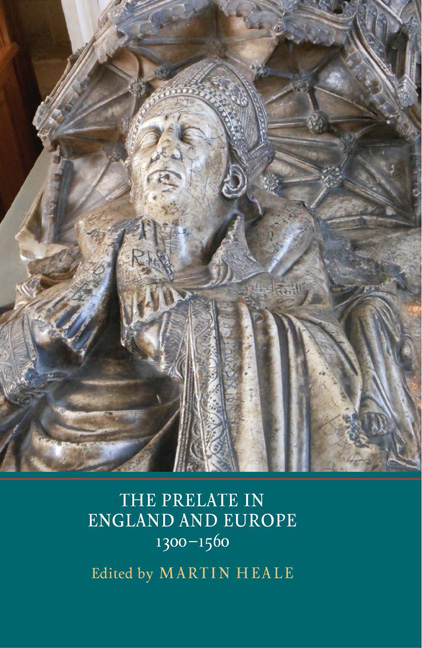Book contents
- Frontmatter
- CONTENTS
- List of Illustrations
- List of Contributors
- Preface and Acknowledgements
- List of Abbreviations
- Introduction
- Part I Prelates and Power
- Part II Patronage and Learning
- Part III Identity and Display
- Treasure, Material Possessions and the Bishops of Late Medieval England
- Episcopal Embodiment: the Tombs and Seals of Bishops in Medieval England and Wales
- Cistercian Abbots as Patrons of Art and Architecture: Northern England in the Late Middle Ages
- Cistercian Abbots in Late Medieval Central Europe: Between the Cloister and the World
- Part IV Attitudes towards Prelacy
- Index of People and Places
- Index of Subjects
- YORK MEDIEVAL PRESS: PUBLICATIONS
Episcopal Embodiment: the Tombs and Seals of Bishops in Medieval England and Wales
from Part III - Identity and Display
Published online by Cambridge University Press: 05 November 2014
- Frontmatter
- CONTENTS
- List of Illustrations
- List of Contributors
- Preface and Acknowledgements
- List of Abbreviations
- Introduction
- Part I Prelates and Power
- Part II Patronage and Learning
- Part III Identity and Display
- Treasure, Material Possessions and the Bishops of Late Medieval England
- Episcopal Embodiment: the Tombs and Seals of Bishops in Medieval England and Wales
- Cistercian Abbots as Patrons of Art and Architecture: Northern England in the Late Middle Ages
- Cistercian Abbots in Late Medieval Central Europe: Between the Cloister and the World
- Part IV Attitudes towards Prelacy
- Index of People and Places
- Index of Subjects
- YORK MEDIEVAL PRESS: PUBLICATIONS
Summary
The visual representation of a medieval bishop is a familiar one. The mitred figure vested for Mass, blessing and holding a pastoral staff, is widely understood as the visual signifier for the episcopate. The inter-relationship of this image in figural sculpture, glass, manuscripts and sepulchral monuments has elicited much comment, particularly in the context of the creation of episcopal authority and lineage in a specific cathedral or diocese. Sigillographic evidence is, however, very often neglected in such inter-media discussions. This is unfortunate for, unlike manuscripts with their limited audiences, and glass where details are often difficult to discern from the ground, episcopal seals and tombs are usually easily visible and share a number of similar features. Both were in the public arena, representing and projecting an office and providing an embodiment of authority and dignity, while at the same time identifiable with a particular individual. As such, seals and tombs were two of the prime media through which episcopal identity was created and expressed.
This essay will explore the relationship between the seals and tombs of bishops, both in general terms and through case studies. This will demonstrate that such studies, integrated into wider discussions, can add significantly to our understanding of the creation and expression of episcopal identity, both personal and corporate.
- Type
- Chapter
- Information
- The Prelate in England and Europe, 1300–1560 , pp. 191 - 214Publisher: Boydell & BrewerPrint publication year: 2014



